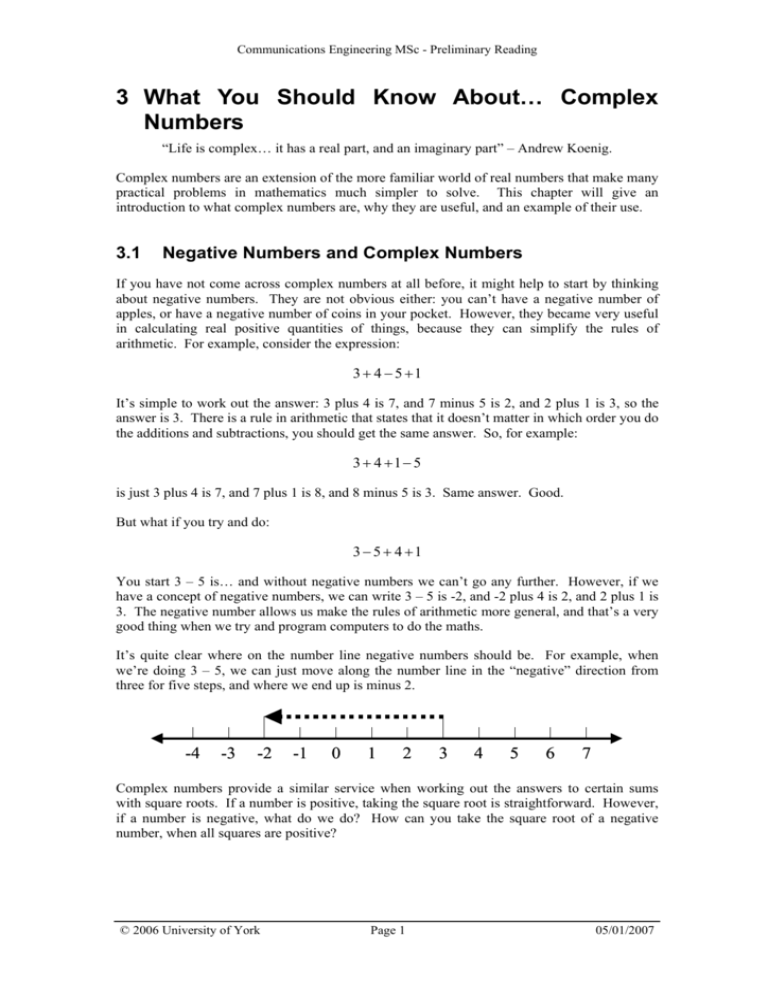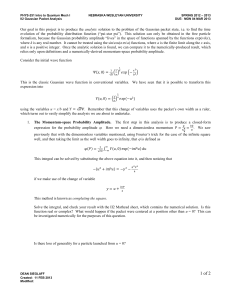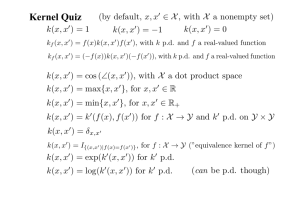PG Reading 03_complexNumbers pdf
advertisement

Communications Engineering MSc - Preliminary Reading
3 What You Should Know About… Complex
Numbers
“Life is complex… it has a real part, and an imaginary part” – Andrew Koenig.
Complex numbers are an extension of the more familiar world of real numbers that make many
practical problems in mathematics much simpler to solve. This chapter will give an
introduction to what complex numbers are, why they are useful, and an example of their use.
3.1
Negative Numbers and Complex Numbers
If you have not come across complex numbers at all before, it might help to start by thinking
about negative numbers. They are not obvious either: you can’t have a negative number of
apples, or have a negative number of coins in your pocket. However, they became very useful
in calculating real positive quantities of things, because they can simplify the rules of
arithmetic. For example, consider the expression:
3 + 4 − 5 +1
It’s simple to work out the answer: 3 plus 4 is 7, and 7 minus 5 is 2, and 2 plus 1 is 3, so the
answer is 3. There is a rule in arithmetic that states that it doesn’t matter in which order you do
the additions and subtractions, you should get the same answer. So, for example:
3 + 4 +1− 5
is just 3 plus 4 is 7, and 7 plus 1 is 8, and 8 minus 5 is 3. Same answer. Good.
But what if you try and do:
3 − 5 + 4 +1
You start 3 – 5 is… and without negative numbers we can’t go any further. However, if we
have a concept of negative numbers, we can write 3 – 5 is -2, and -2 plus 4 is 2, and 2 plus 1 is
3. The negative number allows us make the rules of arithmetic more general, and that’s a very
good thing when we try and program computers to do the maths.
It’s quite clear where on the number line negative numbers should be. For example, when
we’re doing 3 – 5, we can just move along the number line in the “negative” direction from
three for five steps, and where we end up is minus 2.
-4
-3
-2
-1
0
1
2
3
4
5
6
7
Complex numbers provide a similar service when working out the answers to certain sums
with square roots. If a number is positive, taking the square root is straightforward. However,
if a number is negative, what do we do? How can you take the square root of a negative
number, when all squares are positive?
© 2006 University of York
Page 1
05/01/2007
Communications Engineering MSc - Preliminary Reading
3.2
Imaginary Numbers
Minus one has no square root – at least no number on the number line, when squared, gives
minus one. However, suppose we defined the square root of minus one to be j1, so that:
j 2 = −1
Then the square root of any negative number can be readily expressed in terms of j, since:
−a = −1 a = j a
As we’ve noted, there is no number on the number line that when multiplied by itself gives
minus one. So j cannot be on that line: but what if the number line was just one axis of a
plane? Could we find another point on that plane that could be used to represent j? The
answer is yes.
Where would it be? Consider a point in this new number “plane”. We could now represent
numbers in terms of polar co-ordinates – their distance from the origin R, and the angle the line
from the origin to the point makes with the positive number axis θ. In this case, all positive
real numbers would have an angle of zero degrees, and all negative real numbers would have
an angle of 180 degrees.
R
θ
-3
-2
-1
0
1
2
3
4
One could then note that squaring a number results in a new number that has the square of the
length of the original number, and twice the angle. (Twice zero is just zero, so all positive
numbers remain positive, and twice 180 degrees is 360 degrees, which is all the way around
back to the positive real numbers again, so negative numbers have positive squares too.) This
suggests that the line from the origin to j should have a length of one, and an angle of 90
degrees2 – that way j2 would have a length of one, and an angle of 180 degrees: in other words,
it would be minus one.
1
Most mathematicians use i instead of j to represent the square root of minus one. It seems to depend on whether
you’re an engineer (in which case you use i for currents and apparently think it would be confusing to use the same
symbol for both) or not. I’ll use j here.
2
You might notice that using a length of one and an angle of 270 degrees would work just as well. It’s just
convention that puts j at 90 degrees.
© 2006 University of York
Page 2
05/01/2007
Communications Engineering MSc - Preliminary Reading
2j
j
-3
-2
0
-j
-1
1
2
3
4
-2j
The multiples of j are known as the imaginary numbers, and in the number plane (known as an
Argand diagram) they lie on the axis perpendicular to the real number line.
3.3
Complex Numbers
As we’ve seen, one axis on the Argand diagram is the real axis, and on this line lie the real
numbers. The other axis is known as the imaginary axis, and on it lie the imaginary numbers.
Elsewhere in the plane lie the complex numbers, which can be expressed as:
z = x+ jy
where x is the real part of the complex number z, and y is the imaginary part, and j is the square
root of minus one.
Complex numbers are useful for a number of reasons – one being that any polynomial equation
that can be written in terms of complex numbers can be solved in the same terms3. Another
much more useful reason in communications engineering is that they provide a very simple
method of doing calculations involving both the amplitude and phase of an oscillation. In this
case, we can represent the amplitude of the oscillation as R (the distance of the complex point
from the origin) and the phase of the oscillation as θ (the angle between the real axis and the
line from the origin to the complex point):
3j
2j
2+2.6j
R
j
-3
-2
-1
-j
θ
1
2
3
4
-2j
3
This is not true of real numbers: for example it is impossible to solve x2 +3 = 0 in terms of real numbers.
© 2006 University of York
Page 3
05/01/2007
Communications Engineering MSc - Preliminary Reading
The relationship between x, y, R and θ is:
x + j y = R exp ( j θ )
where R = x 2 + y 2 is known as the amplitude or magnitude of the complex number, and
θ = tan −1 ( y / x) is known as the argument or phase of the complex number. (Note that the
angle θ is considered as going anticlockwise from the real axis.) This somewhat surprising
result can be confirmed by considering the Maclaurin series of the complex exponential:
2
3
4
5
jθ )
jθ )
jθ )
jθ )
(
(
(
(
+
+
+
+ ...
R exp ( jθ ) = R 1 + jθ +
2!
3!
4!
5!
( jθ )2 ( jθ )4
( jθ )3 + ( jθ )5 + ...
= R 1 +
+
+ ... + R jθ +
2!
4!
3!
5!
θ2 θ4
θ3 θ5
= R 1 −
+
− ... + j R θ −
+
− ...
2! 4!
3! 5!
= R cos (θ ) + j R sin (θ )
and it’s clear from the diagram that x = Rcosθ, and y = Rsinθ. This turns out to be an
extremely important and useful result. In the case where R = 1, it is known as Euler’s formula:
exp ( jθ ) = cos(θ ) + j sin(θ )
Two very useful results can be derived directly from Euler’s formula:
3.3.1
cos(θ ) =
exp( jθ ) + exp(− jθ )
2
sin(θ ) =
exp( jθ ) − exp(− jθ )
2j
Arithmetic with Complex Numbers
Complex numbers can be added, divided, subtracted and multiplied by considering them to be
the sum of a real and an imaginary part. Functions of complex numbers can be integrated and
differentiated, however these operations are more complicated to perform.
For example:
(a + jb) + ( x + jy ) = ( a + x) + j (b + y )
(a + jb) * ( x + jy ) = ( ax − by ) + j (bx + ay )
© 2006 University of York
Page 4
05/01/2007
Communications Engineering MSc - Preliminary Reading
(a + jb) (a + jb) ( x − jy ) (ax + by )
(bx − ay )
=
= 2
+j 2
2
( x + jy ) ( x + jy ) ( x − jy ) ( x + y )
( x + y2 )
R exp( jθ ) S exp( jϕ ) = RS exp( j (θ + ϕ ))
R exp( jθ ) R exp( j (θ − ϕ ))
=
S exp( jϕ )
S
3.3.2
Complex Conjugates
The complex conjugate of a complex number is a complex number with the same real part, but
an imaginary part that is equal in magnitude but opposite in sign. In other words, the complex
conjugate of (x + jy) is (x - jy).
Imag
z
y
θ
−θ
-y
x
Real
z*
The complex conjugate of z is written as z*. As can be seen from the diagram:
z = x + jy = R exp( jθ )
z* = x − jy = R exp(− jθ )
This leads to the very useful result that:
z z* = R exp( jθ ) R exp(− jθ ) = R 2
In other words the product of a complex number and its conjugate is the square of the
amplitude of the complex number. This is a very important and useful result – if the complex
number is representing the phase and amplitude of an oscillation, then the square of the
amplitude is proportional to the power in the signal.
Any formula using complex numbers remains valid when written using conjugates, and
conjugates can be formed by simply reversing the sign of every j in the formula, for example,
the Fourier transform:
F (ω ) =
∞
∫
f (t )exp ( − jω t ) dt
−∞
could be written in complex conjugate form as:
© 2006 University of York
Page 5
05/01/2007
Communications Engineering MSc - Preliminary Reading
F * (ω ) =
∞
∫
f * (t ) exp ( jω t ) dt
−∞
3.4
Using Complex Numbers to Represent Oscillations
Just like two-dimensional vectors, complex numbers can be used to represent sinusoidal
oscillations: in fact, this is the most common use for complex numbers in communications
engineering. One simple way to do this is by representing the oscillation as the real part of a
complex number multiplied by a complex exponential oscillation of the form exp(jω t) where
ω is the angular velocity (in radians per second) of the oscillation.
Note that:
ℜ {exp ( jω t )} = ℜ {cos (ω t ) + j sin (ω t )} = cos (ω t )
where ℜ { z} represents the real part of the complex number z.
We can then represent any oscillation with this frequency, and with phase θ and amplitude R,
by the complex number Rexp(jθ ), since:
{
}
ℜ { R exp ( jθ ) exp ( jω t )} = ℜ R exp ( j (ω t + θ ) )
= ℜ { R cos (ω t + θ ) + jR sin (ω t + θ )}
= R cos (ω t + θ )
and this provides a simple way to add together oscillations at the same frequency.
There’s another useful way to represent oscillations in terms of complex numbers, and that’s to
combine two complex oscillations: this avoids having to take the real part of the expression.
For example, an oscillation of amplitude R and phase θ could be represented as:
R cos (ω t + θ ) =
R exp ( j (ω t + θ ) ) + R exp ( − j (ω t + θ ) )
2
This is the technique used in Fourier analysis.
3.5
Problems
1) If z1 = 2+3j and z2 = 4-j, what are:
•
z1 + z2
•
z1 – z2
•
z1 z2
•
z1 / z2
2) Evaluate 1 + exp(j π)
© 2006 University of York
Page 6
05/01/2007
Communications Engineering MSc - Preliminary Reading
3) Express
5π
2 exp − j
in terms of its real and imaginary components.
4
4) Starting from Euler’s formula, prove that:
cos(θ ) =
exp( jθ ) + exp(− jθ )
2
sin(θ ) =
exp( jθ ) − exp( − jθ )
2j
5) What would you get if you add a cosine wave of amplitude 10 , frequency 10 Hz and phase
18.4 degrees to a cosine wave of amplitude 2 , frequency 10 Hz and phase 315 degrees?
(Hint – express both in terms of a complex number, and then add the real and imaginary parts
of the two complex numbers.)
© 2006 University of York
Page 7
05/01/2007









